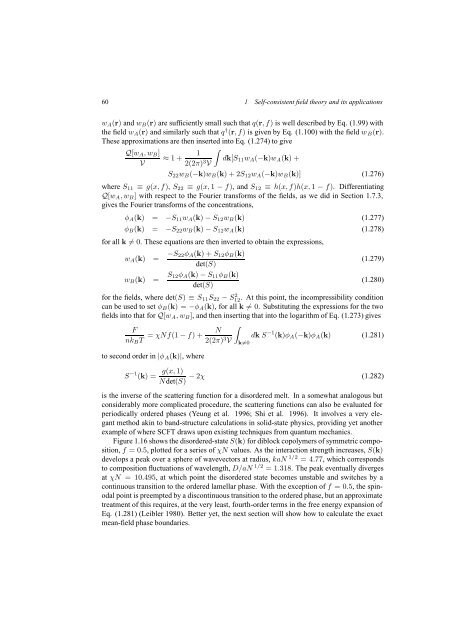Self-Consistent Field Theory and Its Applications by M. W. Matsen
Self-Consistent Field Theory and Its Applications by M. W. Matsen
Self-Consistent Field Theory and Its Applications by M. W. Matsen
You also want an ePaper? Increase the reach of your titles
YUMPU automatically turns print PDFs into web optimized ePapers that Google loves.
60 1 <strong>Self</strong>-consistent field theory <strong>and</strong> its applications<br />
w A (r) <strong>and</strong> w B (r) are sufficiently small such that q(r,f) is well described <strong>by</strong> Eq. (1.99) with<br />
the field w A (r) <strong>and</strong> similarly such that q † (r,f) is given <strong>by</strong> Eq. (1.100) with the field w B (r).<br />
These approximations are then inserted into Eq. (1.274) to give<br />
Q[w A ,w B ]<br />
V<br />
∫<br />
1<br />
≈ 1+<br />
2(2π) 3 dk[S 11 w A (−k)w A (k)+<br />
V<br />
S 22 w B (−k)w B (k)+2S 12 w A (−k)w B (k)] (1.276)<br />
where S 11 ≡ g(x, f), S 22 ≡ g(x, 1 − f), <strong>and</strong> S 12 ≡ h(x, f)h(x, 1 − f). Differentiating<br />
Q[w A ,w B ] with respect to the Fourier transforms of the fields, as we did in Section 1.7.3,<br />
gives the Fourier transforms of the concentrations,<br />
φ A (k) = −S 11 w A (k) − S 12 w B (k) (1.277)<br />
φ B (k) = −S 22 w B (k) − S 12 w A (k) (1.278)<br />
for all k ≠0. These equations are then inverted to obtain the expressions,<br />
w A (k) = −S 22φ A (k)+S 12 φ B (k)<br />
det(S)<br />
(1.279)<br />
w B (k) = S 12φ A (k) − S 11 φ B (k)<br />
det(S)<br />
(1.280)<br />
for the fields, where det(S) ≡ S 11 S 22 − S12 2 . At this point, the incompressibility condition<br />
can be used to set φ B (k) =−φ A (k), for all k ≠0. Substituting the expressions for the two<br />
fields into that for Q[w A ,w B ], <strong>and</strong> then inserting that into the logarithm of Eq. (1.273) gives<br />
F<br />
nk B T<br />
= χNf(1 − f)+<br />
N<br />
to second order in |φ A (k)|, where<br />
S −1 (k) =<br />
2(2π) 3 V<br />
∫<br />
k≠0<br />
dk S −1 (k)φ A (−k)φ A (k) (1.281)<br />
g(x, 1)<br />
− 2χ (1.282)<br />
Ndet(S)<br />
is the inverse of the scattering function for a disordered melt. In a somewhat analogous but<br />
considerably more complicated procedure, the scattering functions can also be evaluated for<br />
periodically ordered phases (Yeung et al. 1996; Shi et al. 1996). It involves a very elegant<br />
method akin to b<strong>and</strong>-structure calculations in solid-state physics, providing yet another<br />
example of where SCFT draws upon existing techniques from quantum mechanics.<br />
Figure 1.16 shows the disordered-state S(k) for diblock copolymers of symmetric composition,<br />
f =0.5, plotted for a series of χN values. As the interaction strength increases, S(k)<br />
develops a peak over a sphere of wavevectors at radius, kaN 1/2 =4.77, which corresponds<br />
to composition fluctuations of wavelength, D/aN 1/2 =1.318. The peak eventually diverges<br />
at χN =10.495, at which point the disordered state becomes unstable <strong>and</strong> switches <strong>by</strong> a<br />
continuous transition to the ordered lamellar phase. With the exception of f =0.5, the spinodal<br />
point is preempted <strong>by</strong> a discontinuous transition to the ordered phase, but an approximate<br />
treatment of this requires, at the very least, fourth-order terms in the free energy expansion of<br />
Eq. (1.281) (Leibler 1980). Better yet, the next section will show how to calculate the exact<br />
mean-field phase boundaries.
















